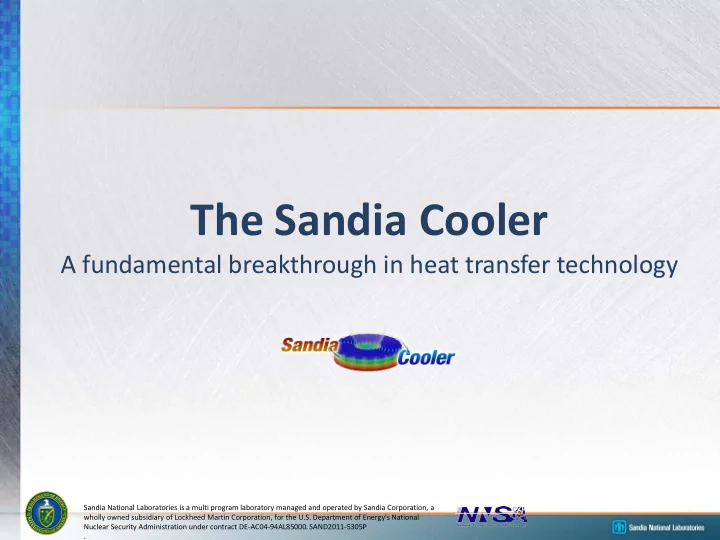

The Sandia Cooler A fundamental breakthrough in heat transfer technology Sandia National Laboratories is a multi program laboratory managed and operated by Sandia Corporation, a wholly owned subsidiary of Lockheed Martin Corporation, for the U.S. Department of Energy's National Nuclear Security Administration under contract DE-AC04-94AL85000. SAND2011-5305P .
Sandia National Laboratories Overview Federally funded R&D center managed by Lockheed Martin under contract to the U.S. Dept. of Energy Sandia's National Security Missions – Nuclear Weapons – Nonproliferation – Homeland Security – Energy & Infrastructure Assurance – Defense Systems & Assessments – Science, Technology, & Engineering
Partnering with Sandia Potential Business Relationships Sandia's primary commercialization goal: – Maximize impact of the technology on U.S. jobs, economic/technical competitiveness, energy savings, etc. Potential business relationships with Sandia: – Licensing of technology from Sandia – Collaborative R&D – Contract Sandia to perform specific work
Value Propositions for Chip Cooling Dramatic increase in cooling performance without resorting to exotic methods 10x smaller than current state-of-the-art CPU coolers Exceptionally quiet operation Virtually immune to dust fouling Simple, rugged, and cost-competitive design Energy-efficient Thermal resistance (CPU/GPU to ambient air): 0.05 C/W Target specifications for Dimensions: 10 cm diameter x 3 cm height Noise level: < 30 dBa radial-flow air bearing heat Per-unit manufacturing cost: <$10 exchanger under development: Electrical power consumption: 5 W
Technology - Summary Description Heat is efficiently transferred across a narrow air gap from a stationary base to a rotating structure that combines the functionality of cooling fins with a centrifugal impeller. Rotation: ~5000rpm (counter- clockwise)
Technology - Detailed Description The hard problems faced by conventional CPU coolers The Problem: The Sandia Solution: The dead air is subjected to The heat transfer a powerful centrifugal bottleneck is the pumping effect, providing a boundary layer of ~10X reduction in boundary “dead air” that clings to layer thickness the cooling fins Noise levels are a Relative motion between the cooling fins and ambient limiting factor in many air is highly aerodynamic applications and thus very quiet High speed rotation virtually Dust fouling degrades eliminates dust fouling cooling performance
Technology - Detailed Description Initial laboratory demonstration
Technology - Detailed Description Thermal resistance breakdown for v. 1.0 prototype R total 10-cm-diameter device R xfer R airgap R internal • The air bearing interface does not constitute a thermal bottleneck. • The main limitation is heat -sink-impeller ambient air heat transfer. • CFD modeling will be used to optimize heat -sink-impeller geometry. • Further reductions in R airgap and R internal will also be pursued.
Technology - Detailed Description Integration Heat pipe incorporation shown below IP related to integration has been developed
Technology - Detailed Description FAQ’s NOTE: A more comprehensive and up-to- date list of FAQ’s will soon be available on Sandia’s IP website: https://ip.sandia.gov/offer_view.php?offer_id=1035 Performance Q: Based on laboratory testing of early prototype devices, what level of performance is expected for a CPU cooler based on Sandia’s air bearing heat exchanger principle? A: We expect to achieve 0.05 °C/W in package that is considerably smaller and quieter than conventional high-performance CPU coolers. Because low-thermal-resistance CPU coolers are particularly susceptible to performance degradation due to cooling-fin fouling (a thin layer of dust can easily increase thermal resistance by a factor of two), the added benefit of immunity to fouling is also a crucial performance specification. Further reductions in thermal resistance would likely involve engineering trade -offs against device size and dBa rating. Manufacturability Q: Does the 0.001 ″ air gap require tight manufacturing tolerances? A: No—the hydrodynamic air bearing gap distance is passively self-regulating. Q: Is the surface quality/flatness spec of a conventional heat sink mating surface adequate? A: Yes— For example, conventional fabrication processes such as cold forging can be used.
Technology - Detailed Description FAQ’s Real-World Practicality Q: Can the device be mounted in any orientation? A: Yes—the air bearing assembly is held together by magnetic attraction (between the stator and permanent-magnet rotor). Q: Is a an air bearing suspension mechanically stiff and rugged? A: Yes—because as with other air bearings, the rate of change of the pressure lifting force with respect to gap distance is extremely large. Q: What other types of equipment use air bearings? A: Devices range from hard disk read–write heads to large CNC milling machine spindles. Q: What if small (< 0.001 ″ ) particulates are somehow introduced into the air gap region? A: They are swept outward and ejected by centrifugal force.
Technology - Detailed Description General & miscellaneous information Product life cycle status: Alpha Scaling: Exploratory work is being initiated on scaling for various applications. Patent Applications: Multiple patent applications have been filed. NOTE: A white paper on the technology is available at the following URL: http://prod.sandia.gov/techlib/access-control.cgi/2010/100258.pdf
Sandia National Laboratories General information Vision: Helping our nation secure a peaceful and free world through technology Year founded: 1949 Major sites: – Albuquerque, New Mexico – Livermore, California
Sandia National Laboratories People and Budget (As of October 15, 2010) FY10 operating revenue On-site workforce: 11,677 $2.3 billion Regular employees: 8,607 13% 13% 43% 31% Technical staff (4,277) by discipline: (Operating Budget) Nuclear Weapons Defense Systems & Assessments Energy, Climate, & Infrastructure Security International, Homeland, and Nuclear Security Computing 16% Math 2% Chemistry 6% Physics 6% Other science 6% Other fields 12% Electrical engineering 21% Mechanical engineering 16% Other engineering 15%
Recommend
More recommend